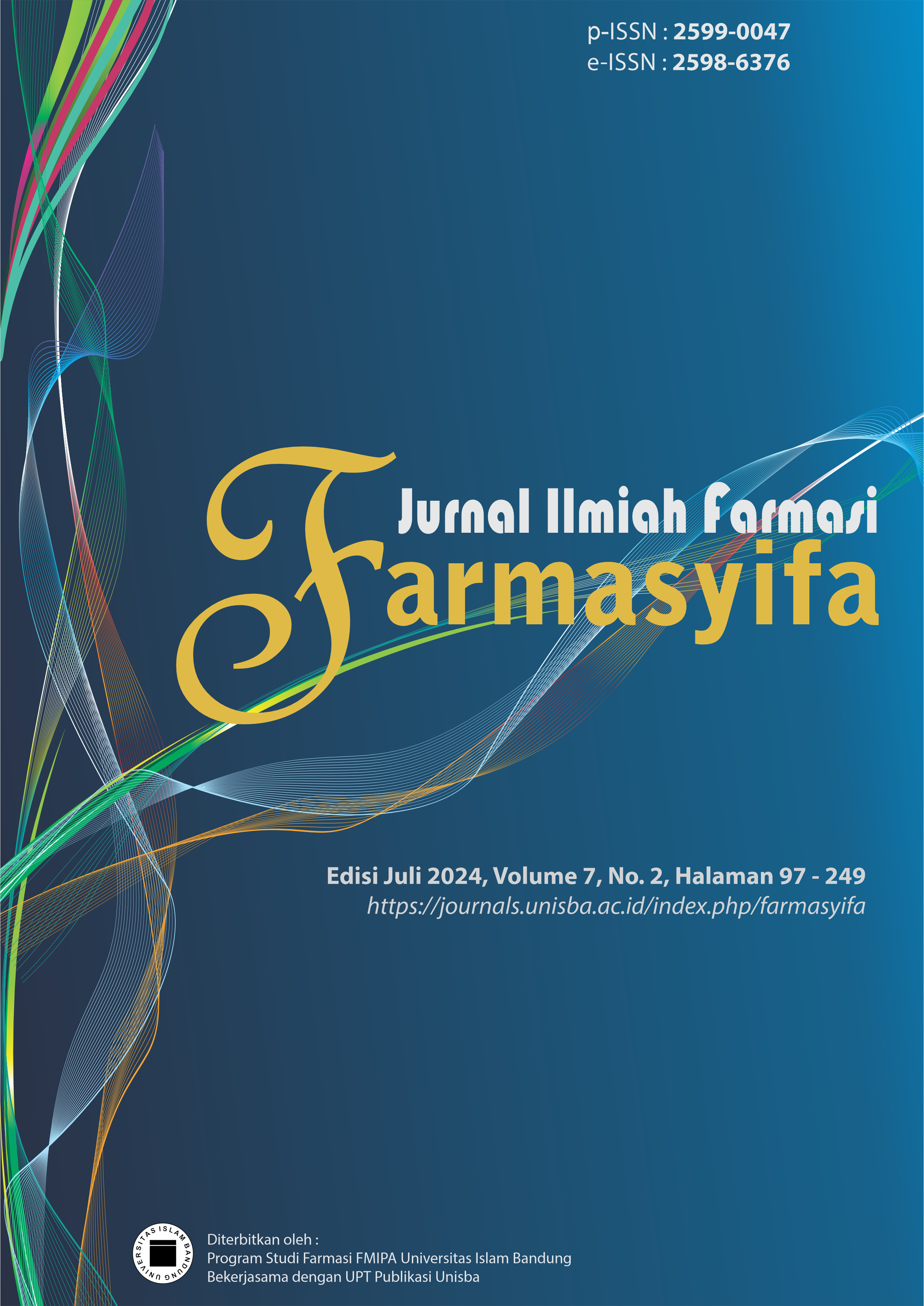THIN-LAYER CHROMATOGRAPHIC PROFILE AND SUNSCREEN ACTIVITY OF ETHANOL EXTRACT 70% KESUM LEAVES (Polygonum minus Huds)
PROFIL KROMATOGRAFI LAPIS TIPIS DAN AKTIVITAS TABIR SURYA EKSTRAK ETANOL 70% DAUN KESUM (Polygonum minus Huds)
DOI:
https://doi.org/10.29313/jiff.v7i2.3667Keywords:
Thin Layer Chromatography, sunscreen, kesum leafAbstract
Polygonum minus Huds. is an endemic plant in West Kalimantan. In Kalimantan, this plant is widely known by its people as one of the biological resources. Kesum has several pharmacological properties such as antimicrobial, anticancer and antioxidant activity and contain secondary metabolites such as phenols, tannins, alkaloids, and flavonoids. The purpose of this study was to identified the thin-layer chromatographic profile and sunscreen activity of 70% ethanol extract of kesum using a UV spectrophotometer. Results from this study, chromatogram profile of 70% ethanol extract of kesum leaves contained stain spots with the Rf value of each secondary metabolite, namely: alkaloids (Rf = 0.72), flavonoids (Rf = 0.64), saponins (Rf = 0.54), tannins (Rf = 0.75), and phenols (Rf = 0.47). The results of sunscreen activity testing obtained the highest SPF (Sun Protection Factor) value of 15.23, the lowest % Erythema Transmission value of 1.53% and the lowest % Pigmentation Transmission value of 6.53%. 70% ethanol extract of chem leaves has high potential as a sunscreen.
References
Adzhani, A., Darusman, F., & Aryani, R. (2022). Kajian Efek Radiasi Ultraviolet terhadap Kulit. Bandung Conference Series: Pharmacy, 2(2). https://doi.org/10.29313/bcsp.v2i2.3551
Ayu, S. I. (2019). Uji Kualitatif Senyawa Fenol Dan Flavonoid Dalam Ekstrak N-Heksan Daun Senggani (Melastoma malabathricum L.) Menggunakan Metode Kromatografi Lapis Tipis. Jurnal Mahasiswa Farmasi Fakultas Kedokteran UNTAN, 4(1).
Balsam, M. S., & Sagarin, E. (1972). Cosmetics science and technology 2nd Ed (2nd ed., Vols. 1–3). John Wiley & Sons.
Departemen Kesehatan Republik Indonesia. (2017). Farmakope Herbal Indonesia Edisi Kedua (2nd ed.). Departemen Kesehatan Republik Indonesia.
Ferdinan, A., Rizki, F. S., Kurnianto, E., & Kurniawan, K. (2022). Fraksinasi dan identifikasi senyawa tanin dari ekstrak pandan hutan (Freycinetia sessiliflora Rizki). Journal Borneo, 2(2), 93–98.
Harbone, J. B. (1987). Metode Fitokimia : Penuntun cara modern menganalisis tumbuhan (Edisi ke :). Penerbin ITB.
Jumadi, A. (2023). SKRINING FITOKIMIA TANAMAN YANG BERPOTENSI SEBAGAI OBAT LUKA LUAR DI KABUPATEN LUWU. Cokroaminoto Journal of Chemical Science, 5(2), 51–54.
Karthika, S, J., & S, P. (2014). TLC and HPTLC Fingerprint Profiles of Different Bioactive Components from the Tuber of Solena amplexicaulis. Journal of Pharmacognosy and Phytochemistry JPP, 3(31), 198–206.
Rahayu, S., Kurniasih, N., & Amalia, V. (2015). Ekstraksi dan identifikasi senyawa flavonoid dari limbah kulit bawang merah sebagai antioksidan alami. Al Kimiya: Jurnal Ilmu Kimia Dan Terapan, 2(1), 1–8.
Rahmawati, R., Muflihunna, A., & Amalia, M. (2018). Analisis aktivitas perlindungan sinar uv sari buah sirsak (annona muricata l.) berdasarkan nilai Sun Protection Factor (SPF) secara spektrofotometri UV-VIS. Jurnal Fitofarmaka Indonesia , 5(2), 284–288.
Rifky, M., Pratiwi, L., & Apridamayanti, P. (2019). UJI KUALITATIF SENYAWA FLAVONOID DALAM EKSTRAK N-HEKSAN DAUN KESUM (Polygonum minus Huds.) MENGGUNAKAN METODE KROMATOGRAFI LAPIS TIPIS. Jurnal Mahasiswa Farmasi Fakultas Kedokteran UNTAN, 4(1).
Tahar, N., Nurfajri Indriani, & Nonci, F. Y. (2019). Efek Tabir Surya Ekstrak Daun Binahong (Anredera cordifolia). . Ad-Dawaa’Journal of Pharmaceutical Sciences, 2(1).
Vikram, P., Chiruvella, K. K., Ripain, I. H. A., & Arifullah, M. (2014). A recent review on phytochemical constituents and medicinal properties of kesum (Polygonum minus Huds.). Asian Pacific Journal of Tropical Biomedicine, 4(6), 430–435. https://doi.org/10.12980/APJTB.4.2014C1255
Widyawati, E., Ayuningtyas, N. D., & Pitarisa, A. P. (2019). Penentuan nilai SPF ekstrak dan losio tabir surya ekstrak etanol daun kersen (Muntingia calabura L.) dengan metode spektrofotometri Uv-Vis. Jurnal Riset Kefarmasian Indonesia, 1(3), 189–202.
Wilkinson, J. B., & Moore, R. J. (1982). Harry’s Cosmeticology (7th edition). Chemical Publishing Company.
Yuda, P. E. S. K., Cahyaningsih, E., & Winariyanthi, N. P. Y. (2017). Skrining fitokimia dan analisis kromatografi lapis tipis ekstrak tanaman patikan kebo (Euphorbia hirta L.). Jurnal Ilmiah Medicamento, 3(2).
Downloads
Published
How to Cite
Issue
Section
License
Copyright (c) 2024 Syumillah Saepudin, Hesty Nuur Hanifah, Kusdi Hartono, Lia Mutiara, Didit Andita

This work is licensed under a Creative Commons Attribution-ShareAlike 4.0 International License.






















